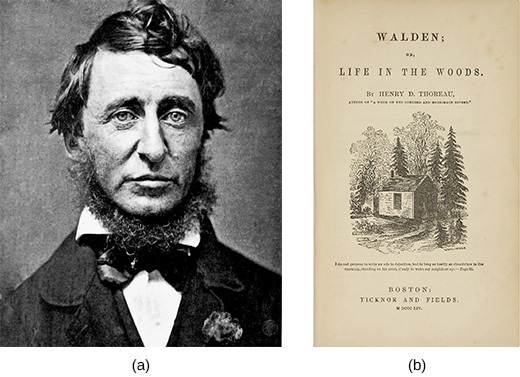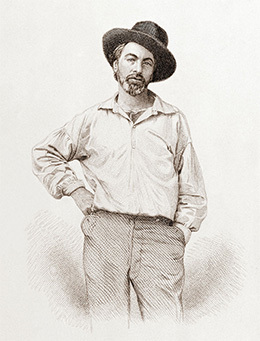| << Chapter < Page | Chapter >> Page > |
Among those attracted to Emerson’s ideas was his friend Henry David Thoreau, whom he encouraged to write about his own ideas. Thoreau placed a special emphasis on the role of nature as a gateway to the transcendentalist goal of greater individualism. In 1848, Thoreau gave a lecture in which he argued that individuals must stand up to governmental injustice, a topic he chose because of his disgust over the Mexican-American War and slavery. In 1849, he published his lecture “Civil Disobedience” and urged readers to refuse to support a government that was immoral. In 1854, he published Walden; Or, Life in the Woods , a book about the two years he spent in a small cabin on Walden Pond near Concord, Massachusetts ( [link] ). Thoreau had lived there as an experiment in living apart, but not too far apart, from his conformist neighbors.

Margaret Fuller also came to prominence as a leading transcendentalist and advocate for women’s equality. Fuller was a friend of Emerson and Thoreau, and other intellectuals of her day. Because she was a woman, she could not attend Harvard, as it was a male-only institution for undergraduate students until 1973. However, she was later granted the use of the library there because of her towering intellect. In 1840, she became the editor of The Dial , a transcendentalist journal, and she later found employment as a book reviewer for the New York Tribune newspaper. Tragically, in 1850, she died at the age of forty in a shipwreck off Fire Island, New York.
Walt Whitman also added to the transcendentalist movement, most notably with his 1855 publication of twelve poems, entitled Leaves of Grass , which celebrated the subjective experience of the individual. One of the poems, “Song of Myself,” amplified the message of individualism, but by uniting the individual with all other people through a transcendent bond.
Walt Whitman ( [link] ) was a poet associated with the transcendentalists. His 1855 poem, “Song of Myself,” shocked many when it was first published, but it has been called one of the most influential poems in American literature.

I CELEBRATE myself, and sing myself,
And what I assume you shall assume,
For every atom belonging to me as good belongs to you.
I loafe and invite my soul,
I lean and loafe at my ease observing a spear of summer grass.
My tongue, every atom of my blood, form’d from this soil, this air,
Born here of parents born here from parents the same, and their parents the same,
I, now thirty-seven years old in perfect health begin,
Hoping to cease not till death. . . .
And I say to mankind, Be not curious about God,
For I who am curious about each am not curious about God,
(No array of terms can say how much I am at peace about God and about death.)
I hear and behold God in every object, yet understand God not in the least,
Nor do I understand who there can be more wonderful than myself. . . .
I too am not a bit tamed, I too am untranslatable,
I sound my barbaric yawp over the roofs of the world. . . .
You will hardly know who I am or what I mean,
But I shall be good health to you nevertheless,
And filter and fibre your blood.
Failing to fetch me at first keep encouraged,
Missing me one place search another,
I stop somewhere waiting for you.
What images does Whitman use to describe himself and the world around him? What might have been shocking about this poem in 1855? Why do you think it has endured?
Some critics took issue with transcendentalism’s emphasis on rampant individualism by pointing out the destructive consequences of compulsive human behavior. Herman Melville’s novel Moby Dick, Or, The Whale emphasized the perils of individual obsession by telling the tale of Captain Ahab’s single-minded quest to kill a white whale, Moby Dick, which had destroyed Ahab’s original ship and caused him to lose one of his legs. Edgar Allan Poe, a popular author, critic, and poet, decried “the so-called poetry of the so-called transcendentalists.” These American writers who questioned transcendentalism illustrate the underlying tension between individualism and conformity in American life.
Evangelical Protestantism pervaded American culture in the antebellum era and fueled a belief in the possibility of changing society for the better. Leaders of the Second Great Awakening like Charles G. Finney urged listeners to take charge of their own salvation. This religious message dovetailed with the new economic possibilities created by the market and Industrial Revolution, making the Protestantism of the Second Great Awakening, with its emphasis on individual spiritual success, a reflection of the individualistic, capitalist spirit of the age. Transcendentalists took a different approach, but like their religiously oriented brethren, they too looked to create a better existence. These authors, most notably Emerson, identified a major tension in American life between the effort to be part of the democratic majority and the need to remain true to oneself as an individual.

Notification Switch
Would you like to follow the 'U.s. history' conversation and receive update notifications?